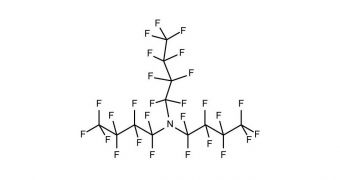A substance that has been in use in the electrical industry for decades was recently demonstrated to be the most radiatively efficient chemical ever discovered. The gas, called perfluorotributylamine (PFTBA), is estimated to be around 7,000 more potent in warming the atmosphere than carbon dioxide.
According to scientists from Canada, PFTBA has the potential to contribute significantly to global warming and climate change, by helping to trap increased amounts of heat reflected off of Earth's surface. The chemical joins CO2 and methane in the list of dangerous greenhouse gases (GHG).
The new investigation was carried out by scientists with the Department of Chemistry at the University of Toronto. The research group says that perfluorotributylamine entered use around the middle of the 20th century, and adds that the emissions of this dangerous chemicals are not regulated in any country.
Analyses of the substance revealed that it has 7,000 times the global warming potential of carbon dioxide. In the particular case of PFTBA, climate change skeptics cannot argue that the chemical is part of Earth's planetary cycle, since it is not produced anywhere in nature, The Guardian reports.
According to a paper the research team published in the latest issue of the esteemed journal Geophysical Research Letters, PFTBA is 7,100 times more potent in promoting global warming over a 100-year period than carbon dioxide. Current atmospheric concentrations are 0.18 parts per trillion.
These levels mean that CO2 and methane remain the most powerful driving forces behind the alteration of our planet's climate. PFTBA is not likely to take the top spot any time soon, but it might contribute to climate change significantly over time.
“We claim that PFTBA has the highest radiative efficiency of any molecule detected in the atmosphere to date,” says UT team member Angela Hong, who was one of the coauthor of the new paper.
“This is a warning to us that this gas could have a very very large impact on climate change – if there were a lot of it. Since there is not a lot of it now, we don't have to worry about it at present, but we have to make sure it doesn't grow and become a very large contributor to global warming,” comments NASA Goddard Institute for Space Studies climatologist Dr. Drew Shindell.
The reason why PFTBA is so dangerous is that it can remain in the atmosphere for up to 500 years, and that it cannot be captured and stored by the oceans. There are multiple mechanisms that mitigate high CO2 and methane concentrations in the air, but none for this dangerous chemical.
“It is so much less than carbon dioxide, but the important thing is on a per molecule basis, it is very very effective in interacting with heat from the Earth. Individually each molecule is able to affect the climate potentially and because its lifetime is so long it also has a long-lasting effect,” Hong concludes.

 14 DAY TRIAL //
14 DAY TRIAL //